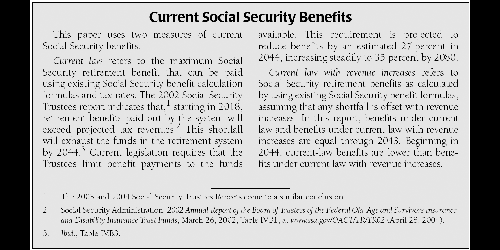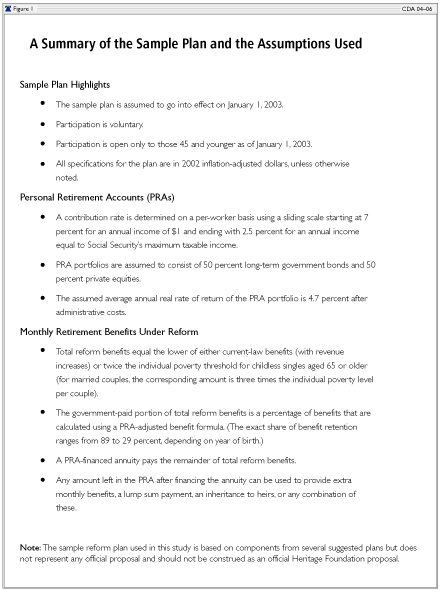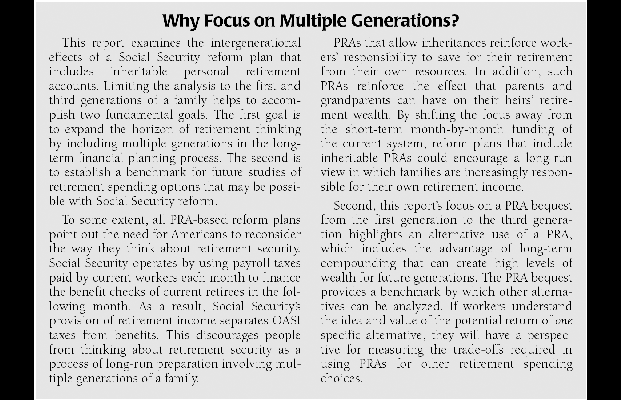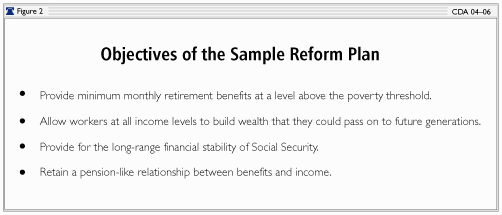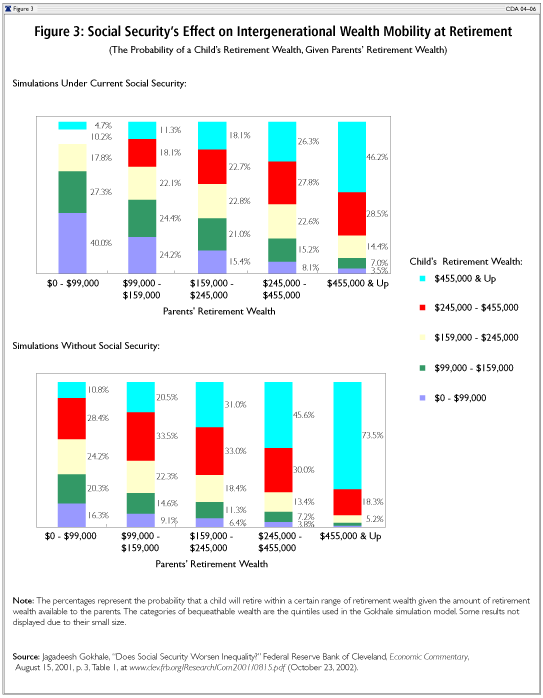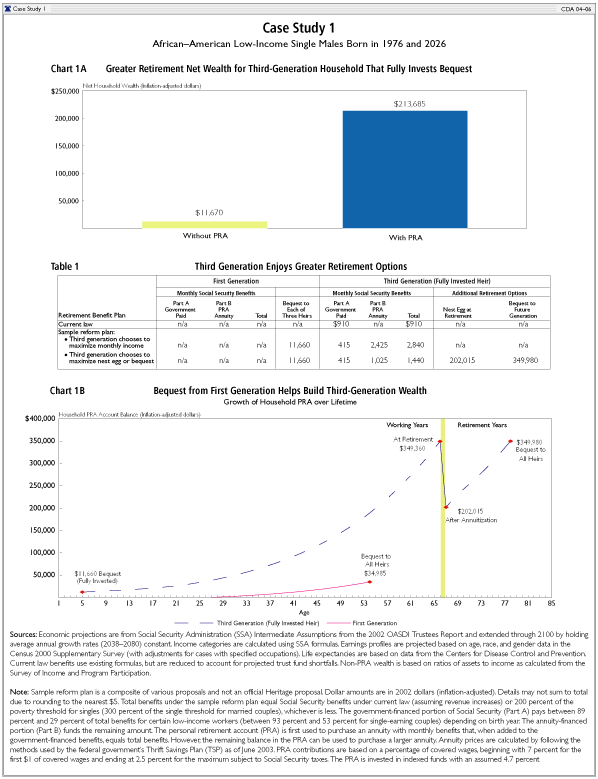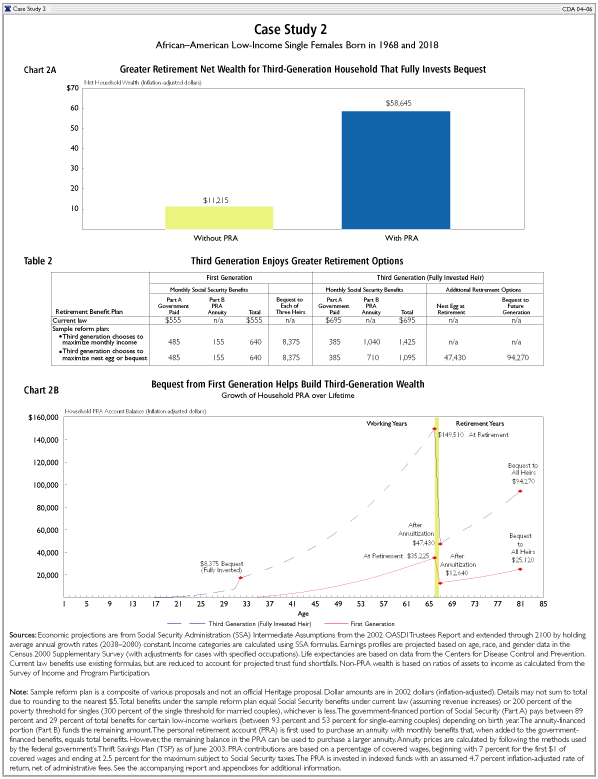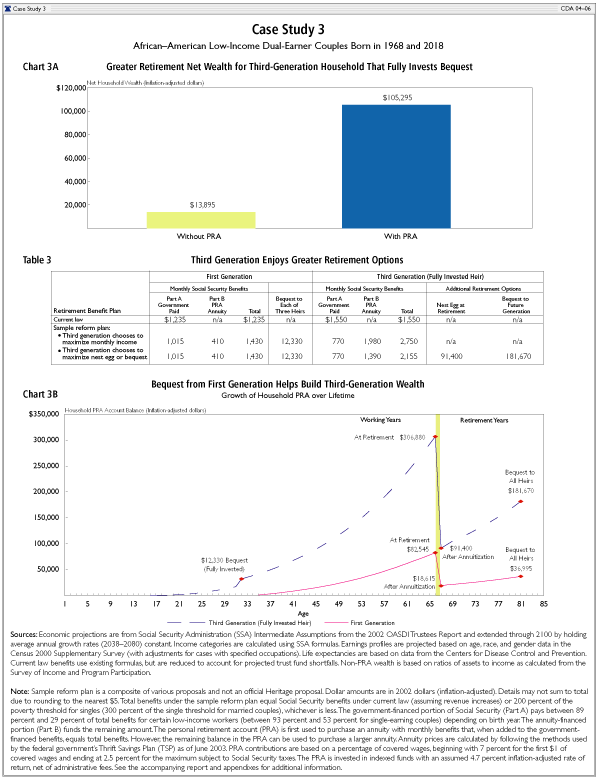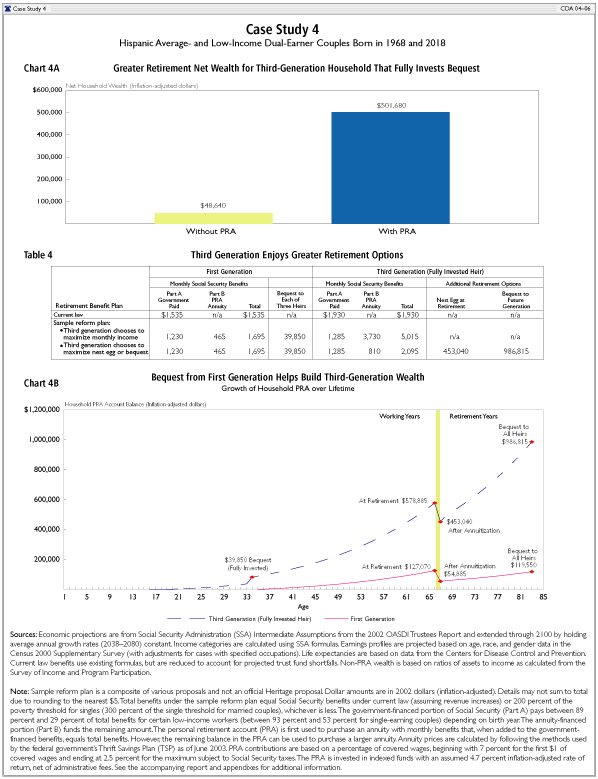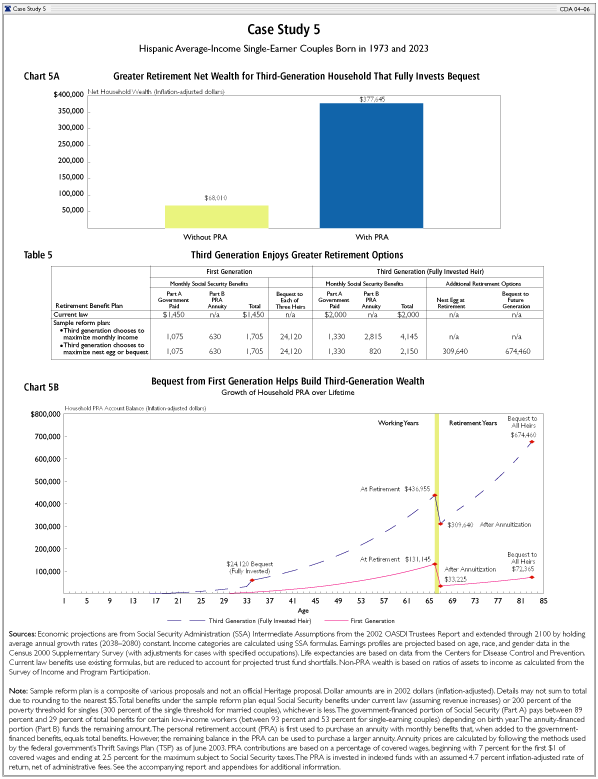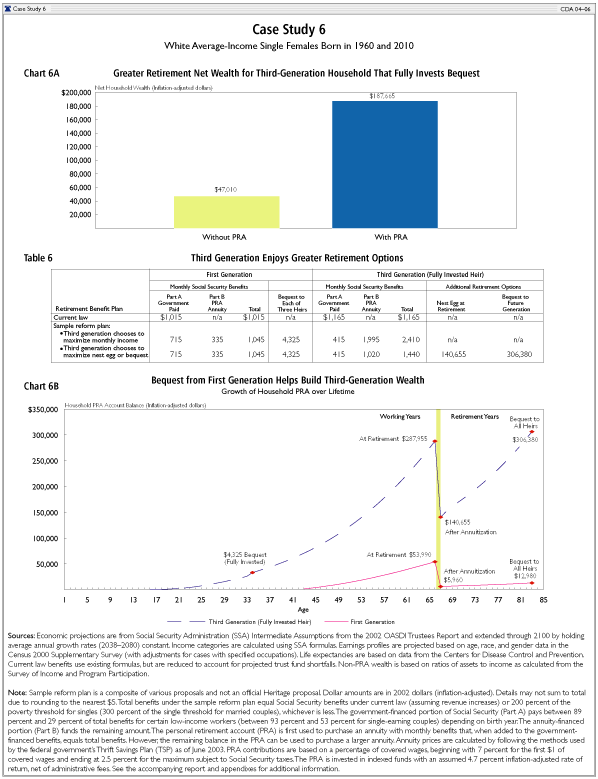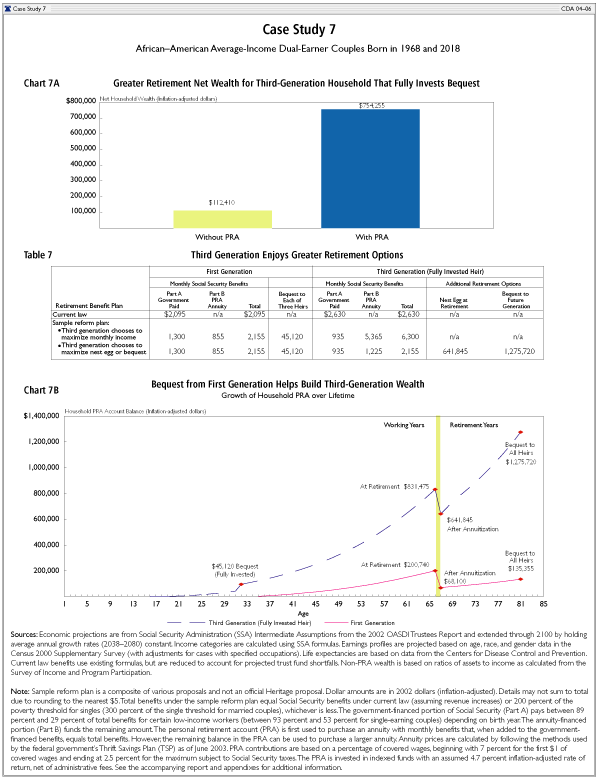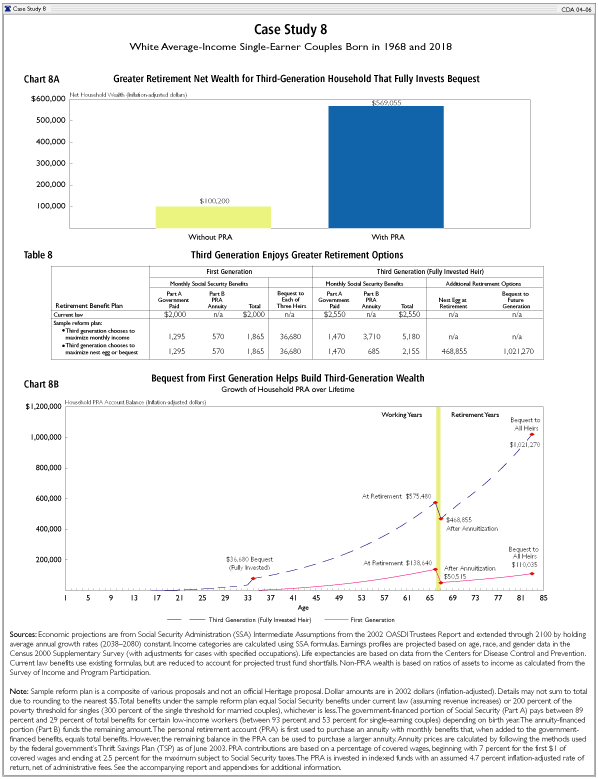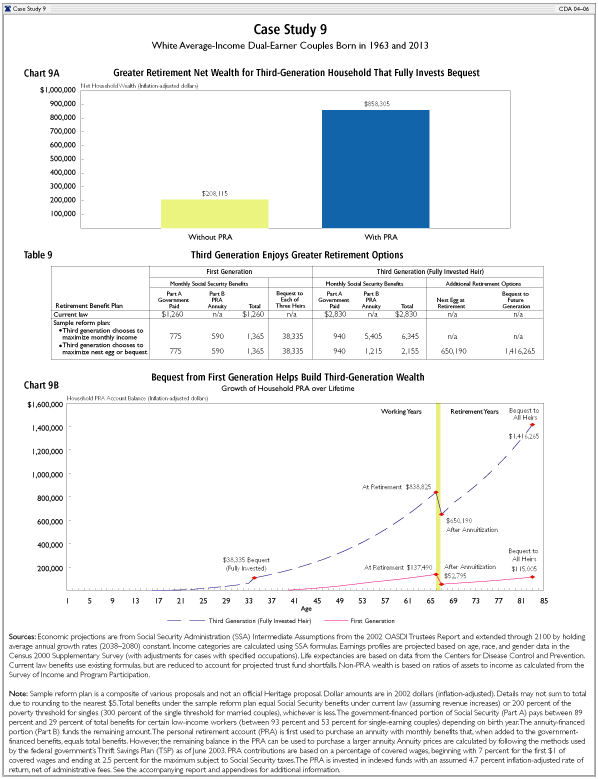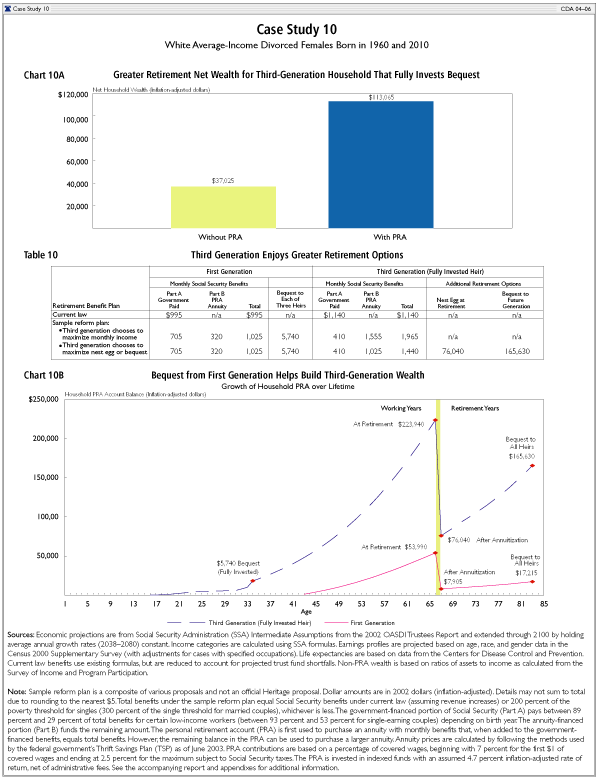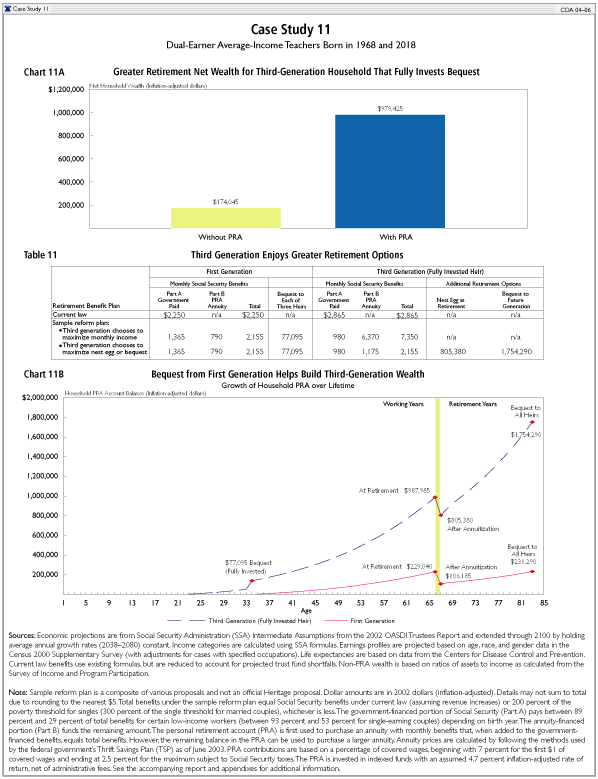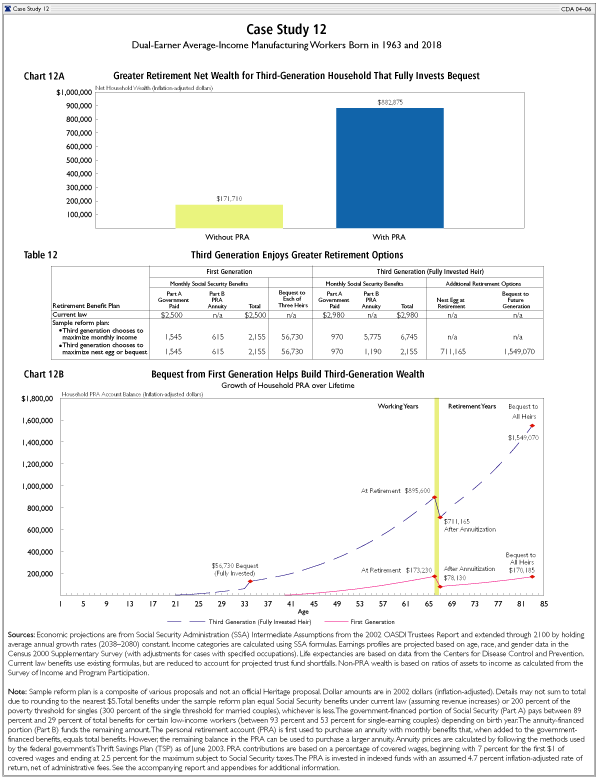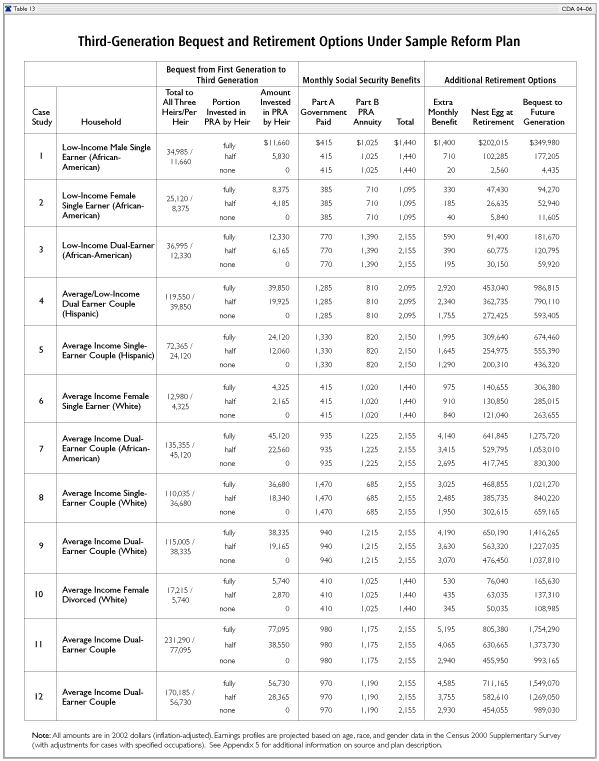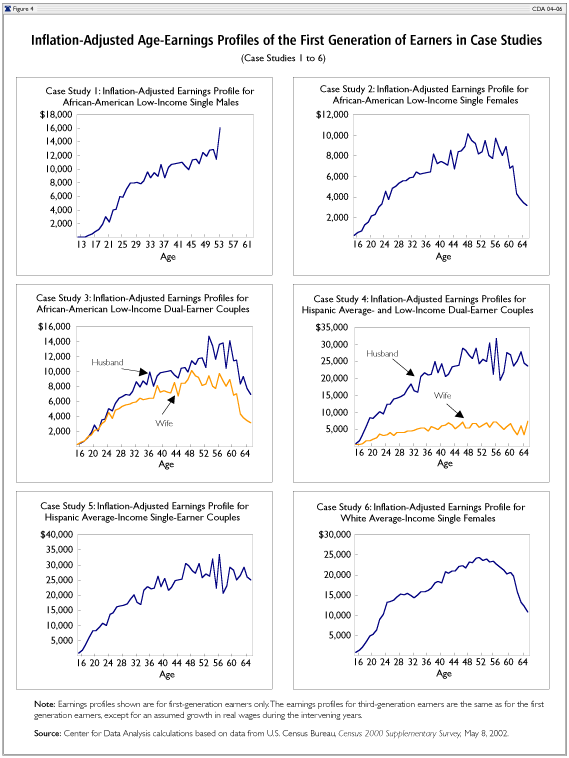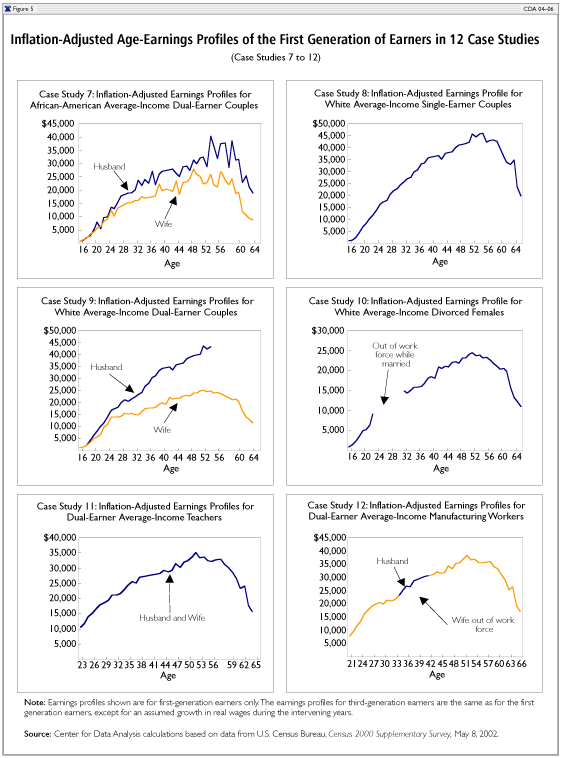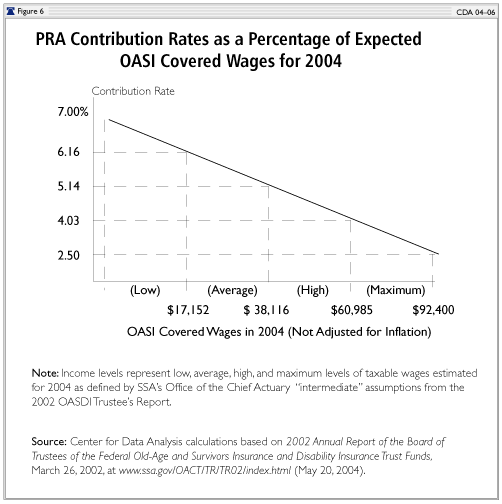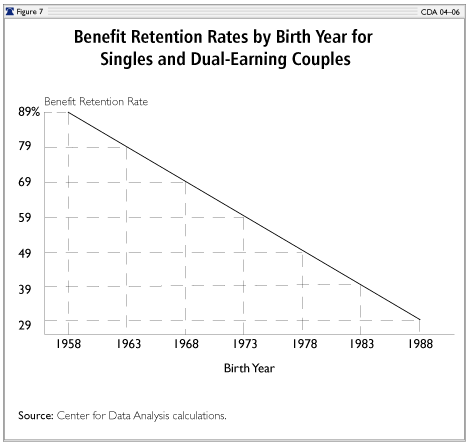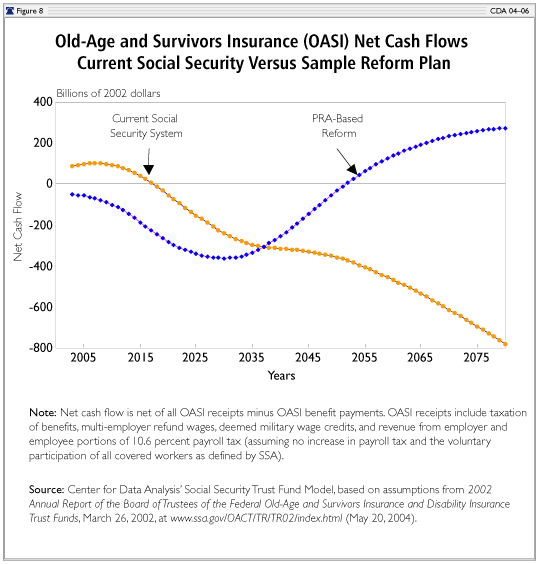Regrettably, under current law, Social Security denies workers retirement options. The current system does not help families to accumulate wealth, because it forces all retiring workers to settle for nothing more than a fixed monthly payment and denies them the chance to build assets over the long term.
As is generally recognized, the current system provides Americans an unacceptably low return on their Social Security payroll taxes. However, few legislative efforts to reform the Social Security system have focused on allowing families to create wealth that they could pass on to future generations. Instead, both defenders and critics of Social Security have discussed reform primarily as a way to address the system’s long-term financial shortcomings. [4]
Defenders of today’s Social Security, for example, respond to the system’s projected insolvency with plans that include tax increases combined with benefit reductions and other fine-tuning adjustments. [5] On the other hand, reformers often advance PRAs primarily as a means to reduce or eliminate the system’s long-term financial deficits. [6]
What This Report Shows
Giving workers the option to invest a portion of their Social Security payroll taxes can greatly improve their long-term retirement security and help them create wealth that they can pass on to future generations. This reform would allow millions of workers to build far more wealth than they otherwise could accumulate. Creation of PRAs is the cornerstone of a wealth-generating Social Security system.
This report by the Center for Data Analysis (CDA) at The Heritage Foundation demonstrates through 12 case studies how Social Security reform could help workers create new and lasting wealth and help provide for their retirement. Since critics of PRAs often focus on concerns for lower-income workers, the 12 case studies focus exclusively on low-income and moderate-income earners.
The 12 case studies in this report assume a reform plan that includes features drawn from several legislative proposals introduced in Congress.[7] The sample plan does not represent any official proposal and should not be construed as an official Heritage Foundation plan. (See Figure 1.)
This report focuses exclusively on how Social Security could create wealth that first-generation families could bequeath to third-generation relatives.[8] The report considers hypothetical workers born between 1960 and 1976 and third-generation heirs born between 2010 and 2026. Income and life expectancy data from publicly available government databases are used to calculate income profiles and life expectancies. The report uses the intermediate-cost economic projections and Social Security assumptions of the 2002 Social Security Trustees Report. These assumptions and projections are not materially different from those of either the 2003 or 2004 Reports.
Reforming Social Security to allow voluntary PRAs would enable workers to build thousands of dollars of additional wealth over a working lifetime. Such wealth creation would allow intergenerational bequests for many more people than currently enjoy them.
As reported by respondents to the Survey of Consumer Finances, less than 13 percent of all households with annual incomes of less than $20,000 receive inheritances.[9] The median legacy for such households is $18,000. Only among families with annual incomes exceeding $100,000 does the frequency of inheritance exceed 25 percent.
Under a program of voluntary PRAs, many more millions of American workers could look forward to an inheritance.[10]
- First Generation: Social Security reform using PRAs can substantially increase the transferable wealth of typical low-income and moderate-income Americans.
A single low-income woman born in 1968 could leave an additional $25,120 to her heirs. (See Case Study 2 and Table 13 in Appendix 1.)
A dual-income married couple with one low-income earner and one moderate-income earner, both born in 1973, could leave an additional $119,550 to their heirs. (See Case Study 4 and Table 13 in Appendix 1.)
- Third Generation: A grandchild or other heir receiving a portion of a first-generation PRA as a bequest could enjoy greatly expanded retirement options.
A divorced, moderate-income woman retiring in 2077 could, if she fully invests her bequest, leave $165,630 to heirs. (See Case Study 10 and Table 13 in Appendix 1).
A single moderate-income woman retiring in 2077 could either receive an additional monthly benefit of $970 or, if she fully invests her PRA bequest, leave $306,380 to her heirs. (See Case Study 6 and Table 13 in Appendix 1).
Overview of Case Studies
The 12 case studies in this paper (see Appendix 1) show how additional wealth creation is possible for workers with a transferable PRA. In addition, they demonstrate how Social Security reform can dramatically expand the wealth of future generations through a bequest mechanism.
The case studies examine intergenerational wealth creation for three generations of American families. (See text box, “Why Focus on Multiple Generations?”) Each family consists of a first-generation low-income or average-income worker and, in several cases, a spouse. Within each family, a case study illustrates how PRAs can enable wealth creation for a first-generation worker and the worker’s spouse; the three third-generation heirs of that worker; and, in several cases, the spouses of those heirs. The distinguishing family characteristics of each third-generation household are assumed to mirror those of its first-generation forebears—e.g., earnings,[11] ethnicity, gender, marital status, and (for two examples) occupation—except for a difference in birth years. All three heirs of the first-generation household are assumed to be born 50 years after the first generation.[12] In all married couples, both spouses are assumed to be born in the same year.
Workers in the case studies join the labor force at age 16, 18, or 21 and retire at age 67.[13] Two of the families have earners with gaps in their work history. Except in two case studies, specific occupations are not assumed for earners in families.
Life expectancies and earnings for the case studies are based on national averages for specific types of families. Among the 12 case studies, four are based on averages for whites, four use averages for African–Americans, two use averages for Hispanics, and two are of unspecified ethnicity. Birth years range from 1960 to 1976 for the first-generation members of families and from 2010 to 2026 for third-generation members.
Three of the families include only workers who are assumed to remain unmarried and without children throughout their working years (thus, their heirs would be regarded as grandnephews or grandnieces rather than grandsons or granddaughters). In one of these three families (Case Study 1), the first-generation unmarried worker dies before retiring but leaves his PRA to three third-generation heirs who do reach retirement age.
Seven families consist of married couples in both the first and third generations. The first generation in Case Study 10 consists of a woman who was married for a time, divorced early during her earning years, remained unmarried until retirement, and had no claim to her ex-husband’s Social Security benefits. The third generation of Case Study 10 consists of the first-generation divorcée’s three female heirs, who also marry and divorce early, remain unmarried until retirement, and claim no part of their ex-spouses’ Social Security benefits. Case Study 9 illustrates wealth creation in the case of a first-generation married couple, in which one spouse dies before retirement, with three third-generation heirs and their spouses, all of whom reach retirement age.
Among the married-couple families (Case Studies 3, 4, 5, 7, 8, 9, 11, and 12), six are dual-earning couples (Case Studies 3, 4, 7, 9, 11, and 12) and two are single-earning couples (Case Studies 5 and 8). In all cases involving married couples, the PRA of the spouse who dies first is combined with the surviving spouse’s PRA. Only upon the death of the surviving spouse is the PRA bequested to third-generation heirs.
Among the 12 case studies, 18 earners are represented in the first generation and 54 earners are represented in the third generation. Six case studies consist of dual-earning couples; four are composed of unmarried workers; and two include single-earning couples. Five of the first-generation workers are low-income earners, while the remaining 13 are average-income earners. Correspondingly, 15 of the third-generation workers are low-income earners and 39 are average-income earners. Among first-generation dual-earning married couples, four of the six include two average-income earners; one includes two low-income earners; and one includes an average-income earner and a low-income earner. Correspondingly, in the third generation, 12 of 18 dual-earning couples include two average-income earners; three couples include two low-income earners; and three couples include one average-income earner and one low-income earner.
The three heirs in the third generation of each case study differ from one another in the way they invest their bequest upon receipt. Under the sample reform plan, workers may either continue to invest all or part of the bequest in the PRA or consume it. The case studies assume that one of the three third-generation heirs saves the entire bequest at least until retirement, a second heir saves half of the bequest until retirement, and the third heir saves none of the bequest. Tables 1 through 12, within Case Studies 1 through 12, show the results for the third-generation heir who fully invests the bequest into a PRA. Table 13 displays results for all three heirs in each case study.
Description of the Sample Social Security Reform Plan. The sample plan used in this paper seeks to meet the four objectives listed in Figure 2.
To meet the first and fourth objectives, the sample reform plan uses two methods to fund the total benefit, which equals either (1) twice the poverty threshold for persons age 65 and above not living with minor children[14] or (2) the benefits promised under current law assuming revenue increases, whichever is less. The government pays one type of benefit, while the other type is paid by an annuity financed out of the worker’s PRA at retirement.
The government-paid portion of benefits is calculated using PRA-adjusted benefit formulas similar in structure to the formulas used under current law. The government-paid benefit amounts are modified using a benefit retention formula that varies between 89 percent and 29 percent, depending on the year in which the retiree is eligible for full benefits. The government portion of benefits cannot exceed total retirement benefits under the reform plan. If a worker’s government-paid portion of benefits is less than the total benefit, the worker’s PRA-funded annuity finances the difference.[15] Single-earner couples and those who meet current-law requirements for the Special Minimum Personal Insurance Amount would continue to receive special consideration under the sample plan.[16]
The worker’s PRA is funded with a portion of his or her taxable earnings. PRA contribution rates are determined by the worker’s annual earnings, using a linear scale beginning at 7 percent for $1 and ending at 2.5 percent for each year’s Social Security maximum taxable earnings.[17] The PRA contribution rate determines the share of Social Security taxable earnings that is contributed to the worker’s PRA for the year. According to this scale, the lower a worker’s earnings, the greater the share of earnings that is invested in a PRA. The amount of each worker’s earnings determines the specific contribution made to the PRA each year. (See Figure 6 in Appendix 5.)
The worker chooses PRA investments from a limited range of options, using a model similar to the Thrift Savings Plan (TSP) that covers most federal civilian and military employees. In the case studies, a PRA portfolio of 50 percent stock index funds and 50 percent long-term government bond funds is used, yielding a blended 4.7 percent inflation-adjusted rate of return, net of administration costs.[18] This conservative portfolio mix is comparable to the 4.6 percent estimated portfolio rate of return assumed by the President’s Commission to Strengthen Social Security.[19]
The PRA contribution formula promotes wealth creation even for lower-income earners. Those with the lowest earnings are able to contribute a larger share of their earnings to their PRAs. To ensure adequate time for compounding and to compensate for market fluctuations, all persons age 45 and above on the plan’s January 1, 2003, starting date are excluded from participation.
At retirement, personal wealth remaining in the PRA after purchase of the annuity could be left in the PRA account until the worker’s death.[20] The remaining balance could then be transferred to a surviving spouse, grandchild, or other beneficiary, who could consolidate the funds into his or her own PRA.[21] The beneficiary (if an adult) may at that point consume all or part of the bequested portion of the PRA. If invested, the bequest mechanism extends the period of compounding and helps to produce sizable increases in the PRAs in subsequent generations.
For the third goal, the plan’s fiscal impact was evaluated using a model that analyzes Social Security’s Trust Fund finances. This analysis indicates that the inflation-adjusted cumulative actuarial deficit under the sample reform plan would be less than $11 trillion through 2080—approximately 45 percent of the cumulative actuarial deficit under the current system for the same period. In addition, the estimated net present value of the unfunded liability through 2080 would be approximately 4 percent lower than the current system’s unfunded liability of $4 trillion.[22]
Calculations for Case Studies. Results for the first generation and one type of third-generation heir are presented for each case study in Case Study 1 through Case Study 12 in Appendix 1. Table 13 in Appendix 1 summarizes wealth creation options for three third-generation heirs for each of the case studies. The calculations assume that the sample reform plan went into effect on January 1, 2003.
Chart A in each case study contrasts the net wealth available at retirement with and without a PRA for a third-generation household that fully invests its bequest in the PRA. The bar labeled “Without PRA” depicts the third-generation household’s accumulation of non-PRA wealth. Non-PRA wealth consists of a combination of real estate holdings, motor vehicle wealth, retirement savings, stock and mutual fund holdings, and other financial wealth, minus unsecured debt. During the household’s working years, non-PRA wealth grows in two ways: The household annually increases its holdings of each category of non-PRA wealth by a specified share of its annual household labor income, and each category of household wealth appreciates at a specified growth rate.[23]
The second bar shows net household wealth with a PRA. This amount consists of non-PRA wealth and the PRA balance after the worker purchases an annuity that provides the non–government-paid portion of Social Security benefits. In all of the case studies, there are funds remaining in the PRA even after the worker purchases the required annuity. The remaining balance represents a substantial increase in the worker’s household wealth.[24]
The table in each case study highlights the various retirement benefit options available to first-generation and third-generation households that fully invest their PRAs.[25] Data for the first-generation household are on the left side of the table; data for the third-generation household are on the right side. The top data row shows current-law benefits for both the first and the third generations. The bottom two data rows describe “Monthly Social Security Benefits” paid under the sample reform plan. Monthly benefits under the sample reform are composed of a “Part A” portion paid by the government and a “Part B” portion paid by the annuity purchased from the worker’s PRA.
At retirement, a first-generation worker uses some of his or her PRA to purchase an annuity to finance the Part B retirement benefits. Funds remaining in the PRA after the annuity purchase are assumed to remain invested in the PRA, although the worker makes no new contributions. When the first-generation household dies, the funds in the PRA are bequested to three grandchildren and their spouses or other beneficiaries. This bequest can increase the third-generation heir’s PRA and is exempt from all estate, gift, and generation-skipping taxes.
On the right side of the table, the last two data rows illustrate retirement options for a third-generation household that fully invests its bequest. The middle row illustrates the monthly retirement benefit that the third-generation household may claim if it chooses to maximize its monthly benefit (see “Total” under “Monthly Social Security Benefits”). Amounts shown under “Nest Egg at Retirement” and “Bequest to Future Generation” in the last row illustrate the retirement options if the third-generation household maximizes its nest egg at retirement or its bequest.
Chart B in each case study represents the long-term contribution of PRAs to the net wealth of the first-generation family and the net wealth of one of the third-generation families. The lines show the PRA wealth for each generation at every age. The lower wealth line shows the household PRA wealth of the first generation, while the higher line shows the PRA wealth of the third generation. The drop in wealth at age 67 for both generations is due to the required purchase of a PRA annuity at retirement. For the first generation, the remaining PRA is left to grow at a 4.7 percent inflation-adjusted rate of return (net of administration costs) until the death of the first-generation household, when it is transferred to third-generation heirs as a bequest.[26] The final value of the first generation’s line in Chart B is the total bequest to all third-generation heirs. One-third of the total bequest goes to an heir that fully invests it. This portion of the bequest is added to the third-generation PRA, and the resulting PRA value is shown in Chart B as “Bequest (Fully Invested).”
Although this paper examines transfers from the first generation to the third generation, in practice, the bequest could be made to any generation. As shown in Chart B, when the first-generation household dies and leaves a bequest to the third generation (“Bequest to All Heirs”), there is a large increase in the third-generation household’s PRA account balance (“Bequest (Fully Invested)”). The bequest received from the first generation is also shown in Table 2 for each case study (see “Bequest to Third Generation”). In almost all of the case studies, the decline in PRA wealth resulting from purchasing the annuity is relatively smaller for the third generation than for the first generation. This is largely because the third-generation household benefits from fully investing its bequest from the first generation.
In all the case studies, the third-generation household that fully invests its bequest has substantially greater wealth than the first generation for the following reasons:
- Unlike the first generation, the third generation adds a bequest into their PRA. This transfer of wealth from the first to the third generation dramatically increases wealth because the invested bequest can grow for many years before the third generation retires.
- The third generation begins contributing to their own PRA at the start of their working lives, unlike the first generation, which must wait until enactment of the reform plan to begin investing in personal retirement accounts.
- Later generations are assumed to benefit from sustained economy-wide increases in inflation-adjusted wages as projected by the Social Security Administration.[27]
There is a trade-off between the bequest that the third-generation families receive and the amount of PRA that the first generation uses to increase their monthly retirement benefits. If first-generation retirees use any of their PRA to increase their own retirement income, they will leave less to their heirs. However, in all 12 case studies, it is assumed that the first generation chooses to maximize the amount transferred to the third generation.
Two case studies assume that a first-generation worker dies before retirement. In Case Study 1, a first-generation worker dies at age 55, leaving a bequest to three third-generation grandnephews. In this example, the granduncle’s PRA is bequeathed to the grandnephews at an early age, and the case study shows the wealth creation of one of the three heirs. In Case Study 9, the higher-earning spouse of the dual-earning couple dies at age 55, and the deceased’s PRA is transferred to the PRA of the surviving spouse.
Table 13 shows retirement options for all the third-generation heirs in each case study, including those who do not fully invest their PRA bequest. The table summarizes and extends the third-generation findings displayed in the case study tables. Each case study is identified by a number in the first column on the left. For each case study, the table shows three of the retirement options available to the three third-generation heirs. The top row for each case study shows the retirement options of the heir who fully invests the entire bequest in his or her PRA, through retirement.[28] The second row shows the retirement options for an heir who invests half of the bequest upon receipt, and the bottom row shows options for an heir who invests none of the bequest. In each case study, the more of the bequest PRA that an heir sets aside, the greater is the heir’s retirement benefits.
Summary for Selected Case Studies. Case Study 1 highlights the advantages of PRAs with real property rights by examining two generations of low-income single males in which the first-generation granduncle dies at age 55, well before Social Security retirement benefits would begin. As a result, he leaves his PRA ($34,985) to three grandnephews. This bequest has dramatic effects on the PRA balance of the third-generation heir who leaves the bequest fully invested. This is because the granduncle dies before reaching retirement; therefore, none of his PRA is used to purchase an annuity. Because the grandnephew receives the inheritance in early childhood, the bequest experiences a long period of compound growth. Consequently, when the grandnephew retires, he can purchase a Social Security retirement annuity and still have $202,015 (“After Annuitization” in Chart B) remaining in his PRA.
In lower-income cases, increases in wealth can be particularly striking. For instance, the first-generation low-income single woman in Case Study 2 significantly increases her grandniece’s wealth at retirement. Each of the three third-generation heirs receives one-third of the first-generation bequest, which totals $25,120. Fifty years later, the third-generation heir who leaves her bequest fully invested enjoys a $47,430 nest egg. The grandniece could in turn leave a bequest of up to $94,270 to her heirs.
Case Study 3 is another low-income case, which shows the benefits for a dual-earning couple. The couple would be able to leave a total of $36,995 to third-generation heirs. Three options are shown in Table 3 for the third-generation couple that fully invests their bequest. All of the options are dramatic improvements over the current Social Security system. The couple could increase their monthly retirement benefits by about $1,200 over current-law levels or spend the accumulated amount (the “Nest Egg at Retirement” of $91,400) to help buy a home or purchase retirement leisure. Alternatively, they could leave their remaining PRA invested and generate a bequest of $181,670 to their heirs. The effect of the bequest on the third generation can be seen for this case study in Table 13. While the heir who fully invests the bequest may enjoy a nest egg at retirement of $91,400, the heir who invests only half can set aside a nest egg of $60,775. The third heir, who saves none of the bequest, accumulates a nest egg of $30,150 at retirement.
Case Study 4 shows a husband and wife who both work. When they die, they leave behind a bequest of $119,550. As a result, their third-generation heirs who invest the entire bequest could increase their monthly retirement benefits by $3,085 over the current-law level.
Case Study 10 shows a first-generation divorced woman, earning a moderate income, who has no claim to her former husband’s Social Security benefits. She has an eight-year gap in her work history, dating from before the reform was enacted. Each third-generation heir is also a moderate-income divorcée, with an eight-year gap in her work history and no claim to her ex-husband’s Social Security benefits.[29] The gap in working years highlights one of the reform plan’s critical advantages for a third-generation earner, as compared to the current system. During the years that she was not employed, the money invested in a PRA continues to grow even without further contributions.
The first-generation woman can leave about $17,215 to third-generation heirs. As a result, a granddaughter fully investing her bequest could retire with a nest egg of $76,040. If the third-generation heir chooses to maximize her bequest, she could leave behind $165,630.
The Importance of Wealth Creation
A growing body of research has shown a connection between asset accumulation and several positive intergenerational effects, especially among lower-income families. These reports usually emphasize the effects that wealth has during the formative and adult working years of parents and their children, while the retirement benefits of such wealth creation are often only assumed.
However, a PRA-based Social Security reform could be the capstone to a lifetime of wealth creation. While other forms of saving can improve the worker’s well-being before retirement, voluntary PRAs can help to secure retirement income as well as help future generations build retirement wealth through first-generation bequests. Opportunities for wealth creation are especially helpful for lower-income workers because the benefits of even modest bequests can be large in proportion to the retirement wealth they would otherwise have.
The possession of even modest wealth over the course of a person’s lifetime contributes greatly to that person’s development and economic security, as well as the development and economic security of his or her children. Research by Gautam N. Yadama and Michael Sherraden of the Center for Social Development (CSD) indicates that people with assets may be more future-oriented, prudent, confident about their prospects, and connected with their community.[30] Deborah Page-Adams and Nancy Vosler, also from the CSD, found that, among autoworkers affected by a plant closing, those owning homes were less likely than renters to suffer from depression or alcoholism, even after taking into account differences in income and education.[31]
However, the positive effects of wealth do not stop with the current generation of workers. Other research has shown that wealth accumulation may also produce important behavioral and socioeconomic improvements for families across generations. One set of researchers found that the saving habits of families are more important than family income in predicting teenage saving behavior.[32] Richard K. Green and Michelle J. White demonstrated that children of homeowners are more likely to stay in school and that daughters of homeowners are less likely to have children as teenagers, compared to children of renters.[33] They further concluded that these positive improvements were most dramatic among those with low incomes.[34] Finally, Thomas P. Boehm and Alan M. Schlottmann found that increased levels of home ownership among low-income families lead to increased rates of high school graduation and college attendance for children in those families.[35]
While wealth is important during a person’s developing and working years, it also increases one’s range of retirement options. Expanding retirees’ options over the use of their retirement contributions is vital because wealth at retirement can be used for more than just income security. As one set of researchers observed, “Wealth is something like traveler’s checks: you take them along on vacation ‘just in case,’ but odds are they will remain uncashed and available for sundry goods after the journey is complete.”[36]
For this to happen, however, retirees must have as much control as possible over the disposition of their retirement wealth. Several members of the 1994–1996 Social Security Advisory Council have expressed this view:
While we understand the desire to restrict people from spending down their assets in order to qualify for means-tested transfer programs, we believe that forcing people to convert their [personal retirement account] balances into annuity incomes beyond levels that protect against such behavior goes beyond the reasonable province of the public interest.[37]
Ample evidence suggests that the Social Security system currently locks up far too much retirement wealth, restricting options beyond what is socially necessary or justifiable. Social Security reform with PRAs can address this shortcoming of the current system both by allowing workers to build income security for their retirement years and by facilitating the transmission of wealth across generations.
The behavior of retirees who can choose the amount of retirement wealth to lock into annuities illustrates the need to balance retirement income requirements with funds set aside to offset life’s uncertainties. For instance, in examining Chile’s experience of allowing workers to choose how to receive personal account benefits, Olivia Mitchell reports that only about 40 percent of Chileans choose a life annuity.[38] Also, members of the TIAA–CREF (Teachers Insurance and Annuity Association–College Retirement Equities Fund), a private pension plan for teachers and other educational personnel, seldom choose a fixed life annuity.[39] Such behavior indicates that retirees realize the importance of flexibility over their long-term spending needs and consequently prefer not to lock up excessive retirement income in annuities.
The reasons why retirees choose more liquidity in and control over retirement savings also indicate how PRAs can correct Social Security’s currently restrictive format. Massachusetts Institute of Technology economist James M. Poterba suggests at least three reasons why relatively few retirees choose to purchase annuities: the desire to leave a bequest to heirs, the desire to hold on to savings for precautionary reasons, and the high cost of annuities.[40] A recent survey of financial planners showed that many individuals do not wish to annuitize their assets because of a bequest motive and fear over losing control of their portfolio’s principal.[41]
However, even in the absence of an overt desire to leave a bequest, the desire to keep retirement savings liquid for precautionary reasons still produces higher levels of bequest than might be expected. Because of the dual purpose served by nonannuitized assets (as a reservoir of emergency funds and as a potential legacy for future generations), even the absence of an intention to leave an inheritance results in a high incidence of bequests.[42] This suggests that the fears used to justify Social Security’s restrictions on retirees’ control of their retirement wealth could be overstated.[43]
Bequests can expand the retirement wealth of future generations and could especially help to pull lower-income earners out of the intergenerational poverty trap. Edward Wolff of New York University found that wealth transfers may equalize the distribution of wealth across families. In particular, he noted that, “though wealth inequality has risen in the United States between 1983 and 1998, the increase may have been even greater were it not for the mitigating effects of inheritances and gifts.”[44] Wolff’s “most surprising finding” was that:
inheritances and other wealth transfers tend to be equalizing in terms of the distribution of household wealth. Indeed, the addition of wealth transfers to other sources of house-hold wealth has had a sizable effect on reducing the inequality of wealth. The results appear counterintuitive. Richer households do receive greater inheritances and other wealth transfers than poorer households. However, as a proportion of their current wealth holdings, wealth transfers are actually greater for poorer households than richer ones. That is to say, a small gift to the poor means more than a large gift to the rich.[45]
Research on the possible distributional effects of replacing Social Security with a system of individual accounts corroborates these findings. Jagadeesh Gokhale of the American Enterprise Institute performed simulations to find how individual accounts would affect the intergenerational wealth mobility of hypothetical workers and their families. He found that under individual accounts,[46] younger workers were dramatically more likely to exceed their parents in accumulating wealth at retirement than they were under the current system.[47] This finding is illustrated in Figure 3.
Gokhale’s simulations showed, for example, that under the current Social Security system, children whose parents had less than $100,000 in retirement wealth have a 60 percent chance of exceeding that level. Less than 5 percent would retire with wealth in excess of $455,000. However, under the simulated alternative to Social Security, children whose parents had less than $100,000 in retirement wealth enjoyed an 80 percent chance of exceeding their parents’ wealth level and an 11 percent chance of retiring with an excess of $450,000 in wealth. The children of workers from all five wealth levels that Gokhale modeled were more likely to meet or exceed their parents’ level of retirement under individual accounts than under the current system.
Additional research shows that intergenerational wealth creation can increase intergenerational wealth mobility.[48] This effect is often overlooked in the debate on Social Security reform but could be instrumental in helping to lift future generations of current lower-earning families out of poverty cycles.
Conclusion
If Congress does not reform the current system, Social Security will not be able to provide promised current-law benefits. When Social Security’s easily foreseeable financing problems were pointed out to J. Douglas Brown, one of the system’s founders,[49] he replied that it did not matter because by the time the “flood” of payments came due, he and his generation would be dead.[50] Almost 70 years later, this approach is no longer possible.
A. Haeworth Robertson, a former Social Security Chief Actuary, provided a more constructive approach:
[Any reform plan] has limitations since it is difficult to formulate a perfect program to accommodate a heterogeneous society such as exists in the United States. The best way to accommodate these diverse needs, of course, is to minimize government-dictated standards and maximize individual freedom of choice.[51]
The examples in this paper demonstrate that reforming Social Security through the use of PRAs can provide workers with realistic options for achieving financial independence during retirement in both current and future generations. PRAs can provide higher rates of return and facilitate wealth creation across generations.
These 12 case studies of low-income and average-income families show that American workers could accumulate wealth in the thousands—in some cases, hundreds of thousands—of dollars through a Social Security reform that includes personal retirement accounts. This increased wealth would be available in addition to a maintenance level of Social Security retirement benefits.
PRAs could help millions of American families to build savings and accumulate wealth that they could use during retirement or pass on to future generations, thus becoming part of an overall strategy to provide a lifetime of greater wealth and other benefits. Ultimately, this reform could provide millions of parents, their children, and their grandchildren with the opportunity to attain greater economic security and independence through their own personalized retirement assets.
William W. Beach is John M. Olin Fellow in Economics and Director of, Alfredo B. Goyburu is a Policy Analyst in, Ralph A. Rector is Research Fellow and Project Manager in, Kirk A. Johnson is Senior Policy Analyst in, and Thomas Bingel is Research Programmer in the Center for Data Analysis, and David C. John is Research Fellow in Social Security and Financial Institutions in the Thomas A. Roe Institute for Economic Policy Studies, at The Heritage Foundation. The authors gratefully acknowledge the substantial contributions made by Curtis Myers, a former member of the CDA staff, to earlier versions of this paper.
Appendix 2
Shortcomings of the Social Security Retirement System
Before the advent of Social Security, Americans had a long history of private provision of retirement income. However, the actions of government regulators combined with apprehensions brought on by the Great Depression produced a change in the political climate that caused a loss of faith in this heritage and a turn instead toward a government role in providing retirement security. (See Appendix 3, “Saving Behavior Prior to Social Security.”)
Despite the initial positive returns provided to the first generations covered by Social Security, the system is proving to be increasingly inadequate for current and future workers. Under the current system, most workers effectively lose control of 10.6 percent[52] of their wages due to Social Security taxes—a portion of which might otherwise have been set aside and saved.[53]
The amount of money involved is large, both for the national economy and for individual workers. In 2003, the retirement portion of Social Security took in $456.1 billion in taxes—about 4.2 percent of the U.S. gross domestic product.[54] Meanwhile, the Congressional Budget Office reports that approximately 80 percent of Americans, predominantly low-income and moderate-income earners, currently pay more in payroll taxes than federal income taxes.[55] Overall, the Social Security tax, along with other features of the system, produces significant distortions in the U.S. economy.[56]
Despite the large transfer of tax money into the system, Social Security provides a low rate of return to current and future workers. Previous research has demonstrated the low rates of return that Americans of various ethnic and economic backgrounds are likely to earn under the current system.[57] Similar analysis by the Social Security Administration (SSA) shows that real rates of return are below those typical of privately held investment portfolios consisting of equities and government bonds. [58] For instance, one SSA analysis found that, even including the probability of receiving disability benefits, a single male born in 2004 and earning annual wages equal to each year’s national average wage (as defined by SSA) could expect a real rate of return of only 2.04 percent. Likewise, a single female born in 2004 and earning the same average wage throughout her earning years could expect to receive a real rate of return of only 2.37 percent. [59]
The reason for these low rates of return is straightforward. As pointed out in the 1994– 1996 Report of the Advisory Council on Social Security:
Massive intergenerational transfers have been delivered to current and past retirees who contributed to the system in its early years before there were many retirees, financed by the current generation of workers to whom smaller retirement benefits will accrue under current law. This pattern, often seen during the start up of certain types of social insurance systems, is no longer viable.[60]
As a result, the program will transfer an estimated $9.7 trillion from workers born in 1938 or later to those born in 1937 or earlier. [61] With such backward intergenerational transfers continuing unabated, few claim today that most young workers can get a fair return on their Social Security taxes. [62]
Furthermore, the current retirement system comes with enormous political risks. The values of Social Security retirement benefits are specified by law, but Congress has the authority to change them at any time: for example, by reducing or delaying them. [63] Given the long-term financial difficulties that the program faces, this particular shortcoming presents a serious risk for those individuals who will depend largely on Social Security benefits during retirement. In 2000, for instance, approximately one-third of Social Security beneficiaries relied on Social Security for at least 90 percent of their retirement income, while almost two-thirds of all recipients received at least 50 percent of their income from Social Security.[64]
If the law is not changed, revenues from the Social Security payroll tax are projected to fall below expected total payments for current-law benefits in 2018.[65] Benefits can be paid for a while by selling special Treasury bonds issued to the OASI Trust Fund.[66] However, buying back these special bonds will require that the federal government reduce spending on other government programs, increase taxes, or increase government borrowing.[67] Even so, unless additional action is taken, the OASI Trust Fund will be “exhausted” in 2044, and OASI income from all sources will be insufficient to cover promised benefits.[68]
In addition to Social Security’s low rate of return and its enormous financial and political risks, workers lack property rights to the benefits, as clearly stated in the Social Security Act: “The right to alter, amend, or repeal any provision of this Act is hereby reserved to the Congress.”[69]
Furthermore, in the two most important Supreme Court cases dealing with Social Security, the federal government has argued that there are no property rights to Social Security benefits. In Helvering v. Davis (1937), the government argued that Social Security benefits possess “no contract created by which any person becomes entitled as a matter of right to sue the United States or to maintain a claim for any particular sum of money.”[70] In Flemming v. Nestor (1960), the government’s brief bluntly stated that “this view that such benefits [from Social Security] are ‘fully accrued property rights’ is wholly erroneous,”[71] a position completely affirmed by the Court.[72]
Consequently, without individual property rights to Social Security benefits, there can be no provisions allowing workers to transfer the balance of their accumulated Social Security taxes to heirs in the event of an early death.[73] The “demographic risk” of the current system highlights the shortcoming of this lack of property rights. Data from the National Center for Health Statistics— cited by the SSA in a 1998 memo criticizing rate-of-return analysis—show that approximately one-third of African–American males and 20 percent of white males who reach the age of 50 will die by the age of 70.[74] Furthermore, the introduction to the report of the 2001 President’s Commission to Strengthen Social Security stated that only 65 percent of 20-year-old African–American men could expect to reach age 65.[75] These persons will receive few or no Social Security benefits, and the amounts paid in Social Security taxes cannot be transferred to their heirs.
On the other hand, personal retirement accounts directly mitigate the financial effects of death prior to retirement. Since workers begin paying Social Security payroll taxes when they begin working,[76] PRAs financed out of a portion of Social Security payroll taxes would offer workers the chance to begin investing at an early age. Research indicates that the proportion of earnings saved and the timing of saving exert a bigger influence in determining accumulated retirement savings than earnings levels or “luck” in the stock market.[77] By ensuring that every worker starts to save with his or her first paycheck, PRAs ensure a lengthy investing horizon that can take full advantage of long-term investment performance. In addition, if a worker suffers an untimely death, previous saving efforts will not be lost, as happens under the current Social Security system.[78]
The problems raised by the lack of property rights and by demographic risks are further compounded across generations by the type of benefit that Social Security provides to retirees. Upon retirement, Social Security benefits are paid out monthly and adjusted annually for inflation. Social Security thus provides the equivalent of an “immediate life annuity” that lasts only until the retiree— or a spouse, if the spouse is receiving spousal benefits—dies.[79] In essence, Social Security retirement benefits are forcibly locked into a single source on the worker’s behalf—a kind of forced annuitization.[80]
The impact that this locking up of retirement wealth has on retirees depends on how much of their total retirement wealth consists of Social Security benefits. Survey results from the Health and Retirement Study show that the bottom 10 percent of those with net financial retirement wealth receive over 90 percent of their retirement wealth from Social Security benefits, while those in the bottom third receive over 60 percent from this one source.[81]
As a result, lower-income earners—who have the majority of their forced lifetime savings locked up for use in this single type of benefit—have their retirement spending choices largely restricted. Jagadeesh Gokhale of the American Enterprise Institute studied the effects of this locking up of retirement savings on lower-income earners. In particular, he found that Social Security may severely curtail the ability of poorer retirees to leave inheritances:
This forced annuitization of a large fraction of low earners’ lifetime resources leaves them with little bequeathable wealth during retirement. Hence, low earners leave few, if any, bequests upon death.… Because of its asymmetrical impact on saving by low and high earners, Social Security reduces or eliminates inheritances of children in poor households but not those in rich ones.[82]
Social Security reform that includes PRAs could overcome this excessive locking up of retirement resources and widen the availability of inheritances for lower-income households. However, the constraints imposed by the financial and demographic shortcomings of the current Social Security system require a fresh approach to reform, including more than just the addition of PRAs. (See Appendix 4, “Alternatives to Forced Annuitization.”)
Appendix 3
Saving Behavior Prior to Social Security[83]
The experience of the early 20th century shows that consumers, when given a choice in the marketplace, repeatedly favor plans that combine a retirement income with benefits that can be passed down to children. During the 19th century, Americans relied heavily on fraternal societies to provide financial benefits for their spouses in old age and for their children. By 1920, about 9 million individuals (representing one-third or more of the adult male population) belonged to one of the more than 100,000 lodges in the United States. A key motivation for joining was to secure future protection for family members, principally spouses. For this reason, the most popular fraternal plan was the death benefit paid primarily to widows, averaging more than $1,000 (equivalent, in most cases, to one year’s income) and totaling over $9 billion by 1920.[84]
Simultaneously, around the turn of the century, commercial insurance companies scrambled to meet a growing consumer demand for products that would provide families with retirement income as well as financial security. The most popular of these was semi-tontine insurance. First introduced in the 1870s, it was sold directly to Americans by commercial life insurance companies. By 1905, 9 million Americans (out of the 18 million households in the United States) owned such a policy, whose combined value constituted an impressive 7.5 percent of all national wealth.[85]
Semi-tontine insurance was popular because it filled a real need for breadwinners and their families by simultaneously guaranteeing retirement income and a fixed benefit to children and spouses. Two types of premiums were paid: one for life insurance and another to fund a retirement income pool that matured at a fixed term—usually 20 years—and was split among the participants remaining after the 20 years.[86] As a means of savings and investment, semi-tontine insurance served a function similar to that of the modern individual retirement account (IRA) while also guaranteeing life insurance for the families of policyholders, whether or not they had qualified to participate in the division of the pool.[87]
Legislation in the first decade of the 20th century put an end to this promising innovation. The New York State Legislature’s 1905 Armstrong Investigation spearheaded this assault by charging semi-tontine insurance providers with fraud and abuse,[88] despite a lack of evidence and in the face of real rates of return of 7.8 percent compared to only 6.1 percent in normal savings accounts.[89]
The destruction of semi-tontine insurance was followed by a rapid expansion of private pension plans. During the 1920s, the assets of pension funds skyrocketed from $50 million to $500 million. By 1929, there were 440 private pension plans in operation, up from about a dozen in 1900. In 1928, some 5 million workers—approximately 14 percent of the workforce—were covered by industrial pensions: 4 million by companies and 1 million by unions. Furthermore, the initial plans were usually noncontributory, meaning that employees made no direct contributions.[90]
Even with the economic collapse of the 1930s, industrial pension plans remained sound and even grew at an increasing rate. By 1932, only 3 percent of workers who had been covered before 1929 were in plans that were suspended, closed to new entrants, or eliminated. By 1935, there were 750 plans compared to 420 in 1930. The new plans eliminated long service requirements, promised higher benefits, placed greater reliance on employee contributions instead of the noncontributory approach, gave workers who switched jobs greater portability, and increased safety through commercial reinsurance.[91] By 1935, most plans allowed workers to withdraw their annuities and use the funds for other purposes, including down payments on homes.[92]
Despite bad economic times and interference by an overzealous government, previous generations left a legacy of prudential retirement planning. The establishment of personal retirement accounts through Social Security could be a bridge from America’s past savings heritage to a more secure and choice-laden future.
Appendix 4
Alternatives to Forced Annuitization
“These constraints required that we begin to ‘think outside’ the normal boundaries of public policy that have constrained the development of Social Security policy for more than 60 years.”[93] This policy advice from members of a recent Social Security advisory board reflects the challenges of balancing Social Security’s finances while trying to maintain the current Social Security tax and benefit structure. In order to avoid relying on increased payroll taxes, PRA reform plans typically introduce new ways to deliver retirement benefits. In particular, they limit the level of forced annuitization and fiscal burden imposed on future generations by the current method of calculating Social Security benefits.
The current method of calculating initial benefits[94] contributes not only to excessive forced annuitization, but also to the fiscal burden that will have to be borne by future generations of workers. Although the current wage-indexing method was designed to correct a previous calculation error that expanded benefits far beyond the fiscal capacity of the Social Security system to handle,[95] it still produces benefits much higher than the historical level prior to the 1970s.[96] As a result, the current wage-indexing method increases the tax burden of future generations and contributes to expected future funding shortfalls.[97]
When the current method was adopted, some analysts expressed reservations about how the wage indexing of benefits might affect future Social Security financing.[98] In 1976, an independent Consultant Panel on Social Security unanimously recommended using a benefit formula based on price indexing, limiting the growth of initial Social Security benefits to the inflation rate.[99] The panel’s primary concern was the cost to future taxpayers of funding benefits using a wage-indexing method, which in turn would reduce Congress’s control and flexibility over the Social Security program.[100]
In 1979, members of that year’s Advisory Council on Social Security, including Council Chairman Henry J. Aaron, again recommended a price-indexing formula for initial Social Security benefits.[101] Aside from concerns over the burden that higher, wage-indexed benefits would impose on future generations of workers, this group also questioned the rationale behind the wage indexing of benefits: “[A]s real incomes continue to rise, it is not so easy to justify the requirement that workers and their employers ‘save’ through payroll tax contributions to finance ever higher replacement incomes, far above those needed to avoid severe hardship.”[102]
As a way to minimize forced annuitization, many Social Security reform plans include provisions that would alter how retirement benefits are received. Most of these are based on a “two-tiered” or “double-decker” concept. The first tier consists of a standard minimum benefit designed to stave off poverty during retirement. The second tier, left unannuitized, is then used to provide more flexibility for retirement spending choices.
Examples of such two-tiered plans include the proposal put forward by members of the 1994– 1996 Advisory Council on Social Security, who recommended a minimum benefit limiting the level of forced annuitization.[103] As long as the first tier provided an adequate minimum, they concluded that such a benefit “provided a significant degree of forced annuitization, and that any further requirement was unnecessary.”[104] Their rationale was that “retirees who want to live a more thrifty lifestyle than the general public deem appropriate…should be able to do so without the interference of the government.”[105] More recently, Reform Model 2 of the 2001 President’s Commission to Strengthen Social Security recommended a combination of a high minimum benefit and a return to the price indexing of normal benefits, combined with the option to leave some of the extra benefits from a personal retirement account unannuitized.[106]
The sample plan used in this report includes a benefit formula that uses 200 percent of the individual poverty threshold as part of a multi-tiered benefit plan (300 percent of the individual poverty level for married couples). The 200-percent-of-poverty threshold criterion combined with a PRA has an effect similar to a plan with a price-indexed benefit because both reduce annuity requirements. However, the PRA provides a new option in return for less forced annuitization. In short, the difference between multi-tiered reform plans and the current Social Security system is a difference not just in the amount of benefits, but also in the form of benefits.
Appendix 5
Methodology
General
Unless otherwise noted, all dollar amounts shown in the case studies are in 2002 inflation-adjusted (“real”) dollars and are rounded to the nearest $5. Unless otherwise noted, the economic assumptions used in the report are based on the “intermediate” assumptions in SSA’s 2002 OASDI Trustees Report.[107]
Case Study Demographics
Center for Data Analysis (CDA) analysts used life expectancy estimates by sex and ethnicity from the Centers for Disease Control and Prevention.[108] Life expectancies are for individuals at age 65 and are rounded to the nearest whole year to simplify the calculations. Each married person is assumed to have the same birth year as his or her spouse. Life expectancies for Hispanics are based on those of whites.[109] Divorced workers are assumed not to have any claims to Social Security benefits based on their prior married status.
The demographic characteristics assumed for first-generation workers are also assumed for their third-generation heirs. In general, third-generation life events are assumed to occur exactly 50 years after the equivalent first-generation life events. One exception to this is Case Study 1, in which the first-generation granduncle dies before retirement at age 55 while his third-generation heirs live to their life expectancies. The other exception is Case Study 9, in which the higher-earning spouse of the dual-earning couple dies at age 55 while his or her third-generation heirs (and their spouses) live to their life expectancies.
Earnings Projections
CDA researchers projected each worker’s annual labor earnings as a function of the inflation-adjusted intermediate assumptions for the national average annual wage (the SSA Average Wage Index) published in the 2002 Social Security Trustees report.[110] Because the 2002 Trustees Report projects earnings only to 2080, CDA extended these projections to 2100 using the 2002 Trustees Report’s intermediate assumptions of annual real-wage growth of 1.1 percent.[111] Projections were adjusted for each worker according to whether he or she was an average or low-income earner.[112] Earnings profiles by age, sex, and ethnicity were constructed using data from the Census 2000 Supplementary Survey.[113] Earnings profiles were constructed for six categories of workers: white male, white female, African–American male, African– American female, Hispanic male, and Hispanic female.[114] Most workers were assumed to begin earning covered wages at age 16, while others were assumed to begin working at 21 or 23.[115] Earnings projections for workers with assumed occupations were adjusted for age and occupation,[116] but not for sex or ethnicity. (See Case Studies 11 and 12.) The earnings for first-generation workers are illustrated in Figure 4 and Figure 5.
Non-PRA Wealth
Non-PRA wealth held by workers was assumed to depend on their projected earnings, initial wealth, and rate of wealth accumulation. Initial wealth and the rate of wealth accumulation were estimated specifically for each worker and for each concept of non-PRA wealth, using data from the Census Bureau’s Survey of Income and Program Participation.[117]
Non-PRA wealth was defined as the total of all assets minus all liabilities. The assets and liabilities are summarized into six basic categories:
- Net real estate wealth. The total market value of all real estate holdings minus outstanding mortgage liability. These holdings include primary residences, vacation homes, timeshares, and mobile homes.
- Net non-PRA retirement wealth. The total market value of all IRA, Keogh, 401(k), 403(b), and other defined contribution or voluntary retirement instruments (except for Social Security), net of any loans taken out of the accounts.
- Net vehicle wealth. The total market value of any cars, trucks, boats, recreational vehicles, and other vehicles, net of any debt secured by them.
- Net stocks and mutual fund wealth. The total market value of stocks and mutual funds held in taxable or nontaxable accounts, net of any margin debt.
- Other net financial wealth. All other financial instruments, including checking and savings accounts, certificates of deposit, U.S. Treasury bonds, corporate bonds, life insurance (cash or surrender value), and the balance of loans owed to the individual, net of debt secured by these financial instruments.
- Unsecured debt. All debt not subsumed in the foregoing five categories, including credit cards, unsecured lines of credit, and other short-term and long-term revolving debt.
PRA Contributions
For each year, PRA contribution rates were defined as a share of a worker’s taxable annual earnings and were based on a linear scale determined by those earnings. The linear scale begins at 7 percent for $1 and ends at 2.5 percent for each year’s maximum taxable earnings (otherwise known as the benefit base). The contribution rate and contribution dollar amount for each calendar year (cy) were determined by the following equation:
Equation 1
where Rcy is the contribution rate for a given calendar year, Ecy-nom is the worker’s non-inflation adjusted (nominal) earnings for a calendar year, and Mcy-nom is the OASI maximum taxable wage (or the OASI benefit base) for a calendar year.
Figure 6 is a graphical representation of Equation 1 for 2004 using assumptions from the 2002 Trustees Report. The key points marked on the line represent the calculated PRA contribution rates for four income types as defined by Social Security. For example, a low-income worker with wages of $17,152 in 2004 has a PRA contribution rate of 6.16 percent. A worker earning the maximum taxable earnings of $92,400 in 2004 has a PRA contribution rate of 2.5 percent. Thus, the lower a worker’s earnings, the larger the share of those earnings that the worker can contribute to his or her PRA.
Portfolio Rate of Return
The equities portion of the PRA portfolio was assumed to earn a constant annual inflation-adjusted rate of return of 7.0 percent. This rate followed that assumed by the 1994– 1996 Social Security Advisory Council.[118]
The long-term government bonds portion of the portfolio was assumed to earn at least 3.0 percent per year, net of inflation. This amount was calculated as follows:
- The 2002 Social Security Trustees report assumes that the average annual interest rate is a constant 6.0 percent after 2009 (without adjusting for inflation).[119]
- This interest rate is the rate that is assumed for the special obligation bonds that the Social Security Administration is legally required to keep in its trust fund portfolio. These bonds mature in no less than four years. Yields on 10-year Treasury bonds are therefore at least as high as the yield on special obligation bonds.[120]
- The Trustees assume that the Consumer Price Index (CPI) grows at a steady rate of 3.0 percent after 2005.[121]
- An assumed inflation-adjusted rate of return on the 10-year Treasury bond portfolio was derived by subtracting the 3.0 percent growth in the CPI from the 6.0 percent average annual interest rate assumed by the Social Security Trustees on special obligation debt.
PRA Wealth
All workers were assumed to have a zero PRA balance at the end of 2002, prior to the plan’s assumed effective date of January 1, 2003. For every year of a worker’s remaining work life, his or her PRA was assumed to increase both from the compounding of interest on the previous year’s balance and from new deposits. All calculations were based on end-of-year values. Workers born before January 1, 1958, were excluded from participation in the plan.
The plan assumed that workers can invest their PRAs only in indexed mutual funds. Workers were assumed to invest half their PRAs in stock mutual funds and half in long-term government bond funds. The projected real rate of return on the equity funds was a constant 7.0 percent, [122] and the projected real rate of return on bonds was a constant 3.0 percent. [123] The blended real rate of return on the PRA was 5.0 percent before an administration fee of 0.3 percent was applied to the account. Thus, the PRA grew at a net real interest rate of approximately 4.7 percent.[124]
Social Security Benefits
Current Law. Current-law benefits are the maximum benefit level that can be paid, using current benefit calculation formulas and tax rates, without violating the SSA’s congressional mandate to keep the OASI Trust Fund from going into debt. Current-law benefits for the case studies were calculated in two steps.
The first step used the earnings projections made for each worker. Monthly benefits were calculated based on earnings in the manner currently specified by SSA,[125] and the results were checked against the 2002 version of SSA’s benefits calculator.[126] Spousal and survivor benefits were included for married couples and followed current law. Under current law, a spouse is entitled to benefits if his or her own calculated primary insurance amount (PIA) is less than half of the higher-earning spouse’s PIA.[127] Otherwise, working spouses get their own full PIA benefit. Under current law, a surviving spouse also qualifies for, at most, two-thirds of the combined retirement benefits of the couple when both were alive.[128]
The second step was to adjust benefits to account for the estimated shortfall in funding. SSA projections show that, after 2043, benefits cannot be paid at the level indicated (using current formulas) without an additional source of revenue for the system.[129]
The revenue shortfall was estimated for each year following projected trust fund exhaustion using data from Table IV.B3 of the 2002 Trustees Report.[130] For each such year, benefit reductions were calculated as the absolute value of the ratio between the balance rate and the income rate.[131] This calculation reduced the benefit level so that it was consistent with projected OASI revenue.
Current Law with Revenue Increases. Current-law benefits with revenue increases were calculated by applying currently used benefit formulas and assumptions. However, benefits were not reduced even for the years when a shortfall is predicted. The calculations incorporated the assumption that additional revenue was available to meet projected costs. For years prior to projected trust fund exhaustion, current-law benefits were identical to current-law benefits with revenue increases.
Sample Social Security Reform
Total Reform Social Security Retirement Benefits. Total Social Security retirement benefits under the sample reform amounted to either the lesser of the current-law benefit with revenue increases or 200 percent of the poverty threshold for an individual age 65 who is not living with dependent children.[132] Under the sample reform plan, benefits would be paid through two components. One is a government-paid portion, funded through payroll taxes on a pay-as-you-go basis. The other portion is paid for by a PRA annuity, which each worker purchased with funds from his or her PRA account. Together, these two components summed to the total level of reform Social Security retirement benefits.[133]
Government-Paid Portion of Retirement Benefits. Each worker’s government-paid Social Security benefit was calculated in two steps. The first step used a sample reform benefit formula similar to the current system, except that it included PRA-adjusted bend points and bend-point percentages. Under the sample reform benefit formula, an additional bend point and bend-point percentage is added to the current two bend points and three bend-point percentages. The lowest reform plan bend point is the same as the currently used lowest bend point. The second-highest bend point is set at five times the first bend point. The third is set at 1.3 times the second-highest bend point. The resulting bend point percentages are 0.91 for the first segment, 0.13 for the second segment, 0.05 for the third segment, and 0.01 for the final segment.
The second step used a benefit retention rate (BRR) to adjust the amounts calculated in the first step. The BRR varied with birth year and ranges between 89 percent and 29 percent for singles and dual-earning couples in which neither spouse qualified for the spousal benefit. [134] Workers born in 1958—the first birth year of those eligible to enter the reform plan—have a benefit retention rate of 89 percent. The rate of benefit retention declines linearly by an additional two percentage points for every later year of birth, until reaching 29 percent for those born in 1988. Thus, earners born in 1965, regardless of income level, have a benefit retention rate of 75 percent, while workers born in 1988 or later have a benefit retention level of 29 percent.
Figure 7 is a graphical representation of the BRR for singles and dual-earning couples by birth year. The government-paid portion of retirement benefits for each worker is equal to the benefit calculated using the lower of either the sample reform plan benefit formula (adjusted for the worker’s benefit retention level) or the total Social Security retirement benefit.
PRA Annuity Portion of Social Security Benefits.When the government-paid benefit was less than the total reform plan benefit, the difference was paid through a PRA annuity. The PRA annuity benefit is the minimum amount needed to eliminate the difference between the total reform plan benefit and the government-paid benefit.
PRA Annuity. The sample reform plan requires workers to purchase an annuity upon retirement if their government-paid benefit is less than their total benefit. PRA annuity price calculations are based on the methods used by the federal government’s Thrift Savings Plan (TSP).[135] The price of a TSP annuity varies according to the prevailing “current interest rate index,” which TSP calculates as “a moving average of the 10-year U.S. Treasury rate.”[136] As described above, CDA analysts used the Trustees’ assumption of a 6.0 percent interest rate on 10-year U.S. Treasury bonds and therefore applied this yield as the “current interest rate index.”
Married couples use part of their PRA funds to purchase an annuity providing an inflation-adjusted stream of monthly payments, plus monthly payments for a surviving spouse. The surviving spouse’s income stream from the annuity is two-thirds (66.7 percent) of the retired couple’s previous income stream.[137] The price of such an annuity is calculated by applying a monthly annuity factor. However, the TSP does not currently offer an annuity paying 66.7 percent to a surviving spouse, and therefore provides no such monthly annuity factor. CDA analysts estimated a monthly annuity factor for an annuity that would pay surviving spouse benefits at a 66.7 percent level if TSP offered such an annuity. Then CDA analysts used this monthly annuity factor to calculate the price of the TSP-type annuity.[138]
Very-Low-Income Workers. Very-low-income earners—particularly those whose PIA is lower than the first bend point—receive special consideration under the reform proposal, allowing such retiring workers to keep more funds in their PRA than would otherwise be the case. This consideration takes the form of an adjustment to their BRR. The adjusted BRR is based on the values of the special minimum PIA and the first bend point[139] used by the SSA in calculating benefits. Equation 2 shows the adjusted BRR for these workers:
Equation 2
In Equation 2, BRRadjusted equals the benefit retention rate after the adjustment is applied. BRRunadjusted equals the unadjusted benefit retention rate, which is determined by year of birth alone. In the equations, all BRR values are expressed as a positive number less than one. B is the lowest bend point corresponding to the worker’s year of birth, AIME is the worker’s average indexed monthly earnings, and SMPIA is the special minimum PIA corresponding to the worker’s year of birth.[140]
For example, a single worker born in 1959 and retiring in January of 2026 with full benefits after more than 30 years of covered employment would have an AIME of $1,170. This AIME is low enough to qualify for the adjustment described in Equation 2. The projections in the 2002 Trustees Report indicate that the lowest bend point corresponding to a worker retiring with full benefits in 2026 is $1,272, while the corresponding special minimum PIA for workers with 30 or more years of covered employment is $1,046. Under the sample reform plan, the unadjusted benefit retention level for workers born in 1959 is 87.0 percent. Applying the adjustment in Equation 2, the benefit retention level is increased to 95.24 percent.
Retirement Benefit Options
- Additional monthly payments. Upon retirement, workers may purchase an annuity that adds additional monthly benefits to those already paid to the worker as total retirement benefits. In this case, a worker receives monthly payments in addition to the sum of the government and PRA annuity portions of Social Security benefits. The maximum amount of additional monthly payments that the worker could buy is listed in the case study tables and in Table 13 under the heading “Extra Monthly Benefit.” (See Appendix 1.)
- Nest egg. Alternatively, the worker could withdraw all or part of the funds remaining in his or her PRA after purchasing the PRA annuity and use them for a purpose of his or her choosing. The maximum amount that could be withdrawn is shown in the tables under the heading “Nest Egg at Retirement.”
- Bequest. The retiring worker or household can also save the PRA balance that remains after the PRA annuity purchase and leave it as a bequest to heirs. The remaining PRA balance is assumed to grow during the retirement years, continuing to yield the 4.7 percent real rate of return. The maximum amount of this bequest is shown in the case study tables and Table 13 under the heading “Bequest to Future Generation.” (See Appendix 1.)
OASI Trust Fund Estimates
The Social Security Trust Fund estimates for the sample plan were calculated using CDA’s Social Security Trust Fund (SSTF) model. The model is based on published and supplemental data from the Social Security Administration and covers the period through calendar year 2080. The model also uses CDA-calculated data based on information from special tabulations of the SSA and from SSA’s Office of the Chief Actuary.[141] The model analyzes Social Security reform plans by tracking the income and benefits for 120 birth-year cohorts for each calendar year covered by the analysis.[142] The results indicate a cumulative deficit of $11 trillion under the sample reform plan versus $24 trillion under the current Social Security system.[143]
Figure 8 shows the net cash flow of OASI through 2080 under current Social Security and the sample reform plan. These estimates are typical for many PRA reform plans that produce an early series of cash flow deficits during the transition period, followed by substantial surpluses over the long run.
Simulations Using Fluctuating Rates of Return
The case study results shown in this paper are based on a constant rate of return for the PRA portfolio. In order to test how fluctuating rates of return affect the results, CDA analysts used a set of 1,000 scenarios to simulate wealth creation for each case study. This simulation was performed using a computerized random number generator making independent and equiprobable draws from a 76-year history of normalized nominal yields and inflation-adjusted total returns on long-term government bonds, and normalized inflation-adjusted total returns on large company stocks.[144] The normalization process modified the historical returns, as recorded in Ibbotson (averaging 5.3 percent for the nominal yield and 2.72 percent for the inflation-adjusted total return on long-term government bonds, and 7.4 percent for the total return on large company stocks), to match the average portfolio returns assumed in the non-stochastic portion of this report (6.0 percent for the nominal long-term government bond yield, 3.0 percent for the total return on the bonds, and 7.0 percent for stocks). Each of the 108-year series was considered a scenario containing two rates of return for each year (one for the total return on the bond portion of the portfolio and another for the total return on the equity portion of the portfolio) and a bond yield for each year. Independent draws were made for each year and used to recompute the results for workers in the 12 case studies. Each case study’s results in 1,000 simulations were stored and evaluated.
All first-generation workers in the case studies created wealth in at least 60 percent of the simulations. Third-generation workers who fully invest their bequest create wealth in over 80 percent of the simulations. In addition, over 60 percent of the simulations show wealth creation for all third-generation workers that do not invest any of their bequest.
List of Acronyms
AIME average indexed monthly earnings
BRR benefit retention rate
CDA Center for Data Analysis at The Heritage Foundation
CPI Consumer Price Index
CSD Center for Social Development
OASDI Old-Age, Survivors, and Disability Insurance
OASI Old-Age and Survivors Insurance
PIA primary insurance amount
PRA personal retirement account
SMPIA special minimum primary insurance amount
SSA Social Security Administration
SSTF Social Security Trust Fund
TSP Thrift Savings Plan
